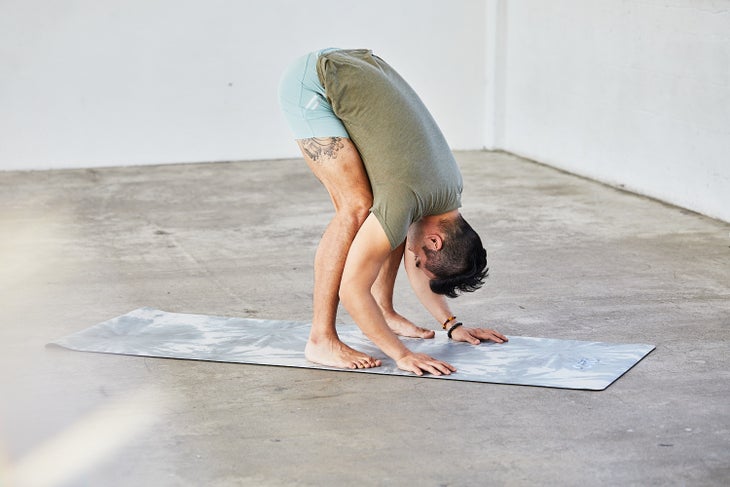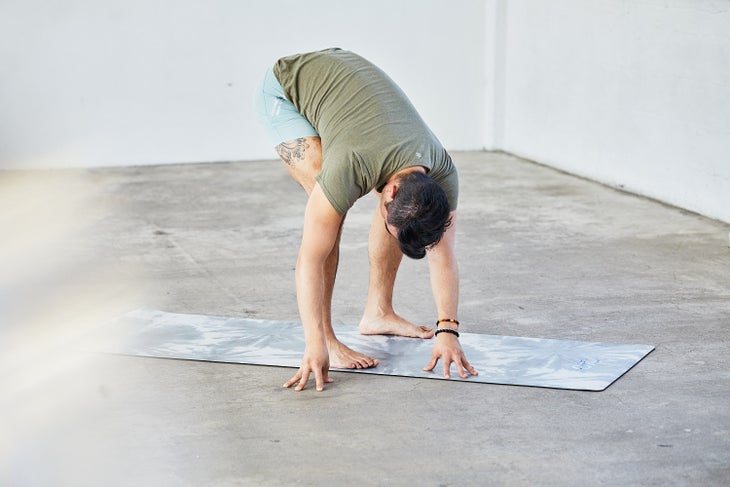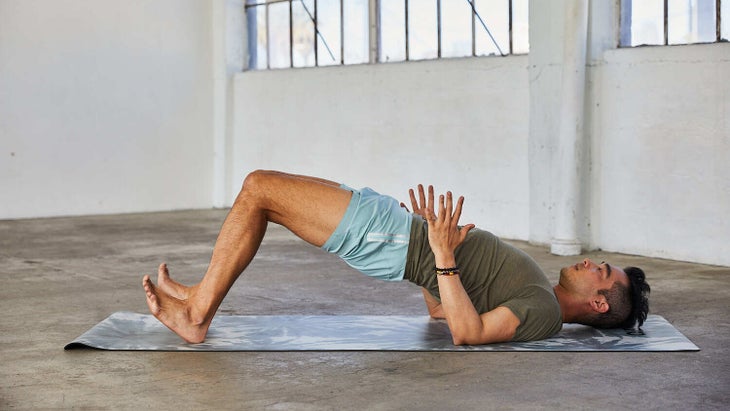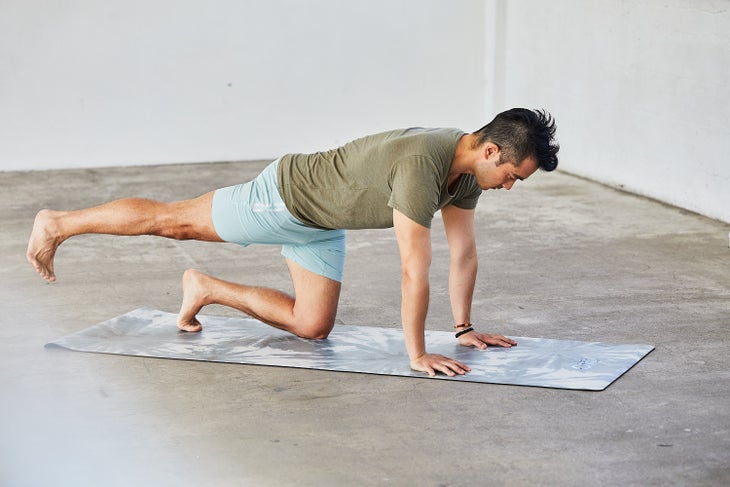Heading out the door? Read this article on the new Outside+ app available now on iOS devices for members! Download the app.
When you experience breathtakingly intense lower back pain, it’s likely that you do one of two things: you remain completely still or you force yourself to move as normally as you can despite being in intense discomfort.
But when your back is in a tightened and traumatized state, both of these approaches can slow your recovery and aggravate your situation—not to mention your mood.
Instead of doing either nothing or way too much, try more passive stretches for lower back pain relief. This approach is based on the principle of reciprocal inhibition, which means when you contract one muscle group, you release the opposing muscle group. So by activating your abdominal muscles, you can help the muscles on your back body to release, if even a little.
Finding Safe Stretches for Lower Back Pain
A large part of the problem for those of us who hesitate to move or stretch at all is fear. When you’re in pain, you begin to distrust your body and your understanding of exactly how much you can safely move. Because passive stretching doesn’t involve contorting your body, it helps ensure you don’t overshoot your flexibility and reestablish trust between your brain and your body. It also allows you to place more of your focus on calming your nervous system, an important and often overlooked part of relieving lower back pain.
More Americans are turning to complementary health modalities such as stretching, and specifically, yoga. An analysis by the National Institutes of Health found that 15.8% of Americans used yoga to manage their pain in 2022 compared to just 5% in 2002.
Each instance of low back pain is unique and will respond to different modalities. Always check with a physician prior to engaging in stretching or any physical activity.
6 Stretches for Lower Back Pain
The following passive stretches include forward bends and slight twists that can help you reestablish trust in your range of motion and find some relief from lower back pain.
As you practice, you’ll want to feel a subtle stretch in your lower back. That’s it. Slowly come out of any pose at any time if you experience pain or discomfort. If you have a herniated disc, avoid doing forward bends.

1. Standing Forward Bend (Uttanasana)
This pose helps counteract compression in your lower back. Forward Bends are also believed to promote relaxation as they encourage your body and mind to turn inward.
How to:
- Stand on the mat with your feet hip-distance apart or wider.
- Bend your knees and slowly hinge forward from your hips.
- Place your hands on the mat or on blocks. Release your neck and let your head hang. Breathe slowly and deeply.
- To release, engage your core and slowly roll up to standing.

2. Child’s Pose (Balasana) With a Side Stretch
Child’s Pose is a physical release but also helps regulate your nervous system, which understandably gets somewhat frazzled when you experience intense pain. Walking your hands to the side stretches your quadratus lumborum, a deep abdominal muscle that runs along your lumbar spine, which is a known trigger point for lower back pain.
How to:
- Come to a kneeling position. Touch your big toes together and lean back to sit on your heels. Separate your knees about as wide as your hips (or wider, if it’s more comfortable). For support, try placing a folded blanket on your calves and sitting back on it.
- Walk your hands forward and bring your chest between your thighs. Try to lengthen your tailbone toward the back wall. Release your hips toward your heels to the point where you feel a light stretch in your lower back.
- Release your forehead on the mat or on folded blankets or a stack of pillows. Tuck your chin slightly. Focus on taking deep, relaxing breaths. If it’s comfortable, stay here for a few breaths.
- Walk your hands toward the right side of the mat until you feel a light stretch in the left side of your lower back. Keep reaching your hips toward your heels to lengthen your back. Try to relax your left shoulder. Breathe slowly and deeply.
- To release, bring your hands back in front of you on the mat. Repeat on your left side.
Variation: If it’s difficult for you to lower yourself to the floor for Child’s Pose, you can experience the same lower back release by standing in a doorway, reaching your arms overhead, resting your hands on the doorframe, and gently leaning to one side. Breathe here for as long as you like. Switch sides.

3. Standing Forward Bend (Uttanasana), Variation
A variation of Standing Forward Bend, this pose targets the quadratus lumborum muscles when you reach to the side. This pose also stretches your hamstrings, glutes, and hips, which could be contributing factors to lower back pain.
How to:
- Stand on the mat with your feet hip-distance apart or wider.
- Bend your knees and slowly hinge forward from your hips.
- Place your hands on the mat or on blocks. Release your neck and let your head hang.
- From Standing Forward Bend, slowly walk your hands toward the right side of the mat, bending your knees even more if needed. Move your blocks to the right side and place your hands on them for support. Try to release your opposite shoulder. (If you’re walking your hands to the right, relax your left shoulder.) Breathe slowly and deeply.
- To release, bring your hands back to center, engage your core, and slowly roll up.

4. Bridge Pose (Setu Bandha Sarvangasana)
This variation of Bridge Pose isn’t about the backbend. Rather than lifting your hips as high as possible, your goal is to engage your glutes. That’s it. Contracting your glutes can create an immediate release in the muscles of your lower back. Strengthening your glutes can deliver long-term support for your lower back.
How to:
- Lie on your back, bend your knees, and place your feet on the floor about hip distance apart.
- Bring your arms alongside your body, bend your elbows, and press the backs of your upper arms into the mat. (This helps relieve pressure on your lower back.)
- Push your feet down into the mat, engage your glutes, and slowly lift your hips any amount that feels comfortable. For a more intense hamstring stretch, try to drag your heels toward your butt without moving them, which will engage your glutes more. Breathe here.
- To release Bridge Pose, slowly lower your body onto the mat and release your arms.

5. Tabletop With One Leg Extended
Practicing this variation of Tabletop is an exercise in stabilizing your core, including your abdominal muscles. This, in turn, can help take some pressure off your lower back. Focus on lifting your leg no higher than your hip and keeping your spine aligned.
How to:
- Come to your hands and knees. Draw your navel in and engage your core and pelvic floor.
- Extend your right leg straight back while keeping the ball of your right foot on the mat. Engage your core as you slowly lift your right leg, using just your glutes or hamstrings. Be careful not to arch your back. If that is painful, keep the ball of your right foot on the mat. Breathe here.
- Slowly bend your right knee and lower it to the mat. Repeat on your left side.

6. Dead Bug
In this standard physical therapy stretch for low back pain, the support of the floor keeps your lower back from arching too much. It’s also a low-impact exercise for strengthening your core. Try it after your most intense lower back pain has subsided—when you feel like you can safely move.
How to:
- Lie on your back with your knees bent and feet flat on the mat. Slowly bring your knees toward your chest and stop when they’re over your hips. Rest your arms along your sides with your palms facing up or reach both arms toward the ceiling.
- Engage your core by drawing your navel toward your spine. Engage your pelvic floor.
- Slowly lower your right foot and touch it to the mat and then bring it back to position. If this feels comfortable, try repeating it a few times.
- Repeat on your left side. To release the pose, bring both feet down to the mat.
This article has been updated. Originally published October 18, 2022.